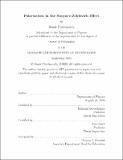| dc.contributor.advisor | Edmund Bertschinger and Alan Guth. | en_US |
| dc.contributor.author | Portsmouth, Jamie, 1974- | en_US |
| dc.contributor.other | Massachusetts Institute of Technology. Dept. of Physics. | en_US |
| dc.date.accessioned | 2005-05-19T15:39:52Z | |
| dc.date.available | 2005-05-19T15:39:52Z | |
| dc.date.copyright | 2003 | en_US |
| dc.date.issued | 2003 | en_US |
| dc.identifier.uri | http://hdl.handle.net/1721.1/17016 | |
| dc.description | Thesis (Ph. D.)--Massachusetts Institute of Technology, Dept. of Physics, 2003. | en_US |
| dc.description | Includes bibliographical references (p. 121-125). | en_US |
| dc.description | This electronic version was submitted by the student author. The certified thesis is available in the Institute Archives and Special Collections. | en_US |
| dc.description.abstract | A novel covariant formalism for the treatment of the transfer and Compton scattering of partially polarized light is presented. In this approach, the polarization state of a light beam is described by a tensor constructed from the time average of quadratic products of the electric field components in a local observer frame. This leads naturally to a covariant description which is ideal for calculations involving the boosting of polarized light beams between Lorentz frames, and is more flexible than the traditional Stokes parameter approach in which a separate set of polarization basis vectors is required for each photon. The covariant kinetic equation for Compton scattering of partially polarized light by relativistic electrons is obtained in the tensor formalism by a heuristic semi-classical line of reasoning. The kinetic equation is derived first in the electron rest frame in the Thomson limit, and then is generalized to account for electron recoil and allow for scattering from an arbitrary distribution of electrons. This formalism is applied to a calculation of the relativistic corrections to the spectral distortions imprinted in the intensity and polarization of the cosmic microwave background radiation (CMB) by inverse Compton scattering in clusters of galaxies (the Sunyaev-Zeldovich effects). We develop a Monte Carlo method for simulating these effects, based on the tensor formalism and kinetic equation. We also consider the use of the polarization signal generated by scattering of the CMB from distant clusters as a probe of cosmological perturbations. | en_US |
| dc.description.abstract | (cont.) Such observations allow an indirect measure of the CMB quadrupole as seen on the last scattering surfaces of observers at nonzero redshift. The statistical properties of this signal in a simple cosmological model are derived. We demonstrate that measurements of this signal would yield more information than is available from observations of the CMB anisotropies on our sky, and would potentially allow more precise measurement of cosmological parameters and the primordial power spectrum of density fluctuations. | en_US |
| dc.description.statementofresponsibility | by Jamie Portsmouth. | en_US |
| dc.format.extent | 125 p. | en_US |
| dc.format.extent | 1992807 bytes | |
| dc.format.extent | 2062488 bytes | |
| dc.format.mimetype | application/pdf | |
| dc.format.mimetype | application/pdf | |
| dc.language.iso | eng | en_US |
| dc.publisher | Massachusetts Institute of Technology | en_US |
| dc.rights | M.I.T. theses are protected by copyright. They may be viewed from this source for any purpose, but reproduction or distribution in any format is prohibited without written permission. See provided URL for inquiries about permission. | en_US |
| dc.rights.uri | http://dspace.mit.edu/handle/1721.1/7582 | |
| dc.subject | Physics. | en_US |
| dc.title | Polarization in the Sunyaev-Zeldovich effect | en_US |
| dc.type | Thesis | en_US |
| dc.description.degree | Ph.D. | en_US |
| dc.contributor.department | Massachusetts Institute of Technology. Department of Physics | |
| dc.identifier.oclc | 54457096 | en_US |
